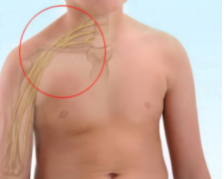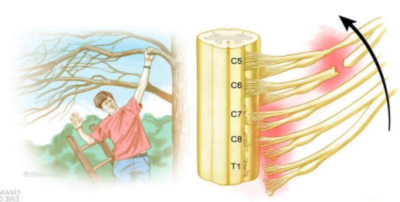


[vc_row][vc_column][vc_column_text]The nerve group which supplies the muscles of the upper extremity is called the brachial plexus.
This is formed by an organized mix and match of 5 different nerves which exit the cervical spine ( bones of the spinal cord including the neck ), move outward and downward in the neck, going under the collar bone, and enter the arm-. They have many branches that supply the various muscles of the arm, forearm, hand back, and chest.
When these nerves are injured due to any reason, the result is an immobile upper limb. The extent of immobility and loss of sensation depends on the type of injury and extent of involvement of these nerves. Even newborns are sometimes found to have an immobile upper limb on one or both sides. This is also caused by injury to the brachial plexus during delivery and has many varied causes.

How do I know I have brachial plexus injury –
After the accident, if you have :
∙ Could not move the shoulder, elbow, hand, or all of the above
∙ Lost sensation in particular areas of the arm, forearm, or hand with or without
∙ severe pain radiating down till the hand and especially so in the night you could have sustained brachial plexus injury.


The best is to consult a plastic surgeon at the earliest. You will need to be evaluated at the earliest, and the best line of treatment decided. If no spontaneous recovery starts by three weeks to a maximum waiting period of 3 months, you will need to undergo surgery at the earliest.
Any further delay in treatment is detrimental to the recovery. Nerve surgery is very time-dependent. A repaired nerve travels at a rate of about 1 mm per day ( faster in younger and slower in older patients ) towards its target muscles. If the nerve impulse does not reach the target muscles by 1 to 1 and half years after the nerve surgery, the muscle is irreversibly damaged. Hence brachial plexus treatment is a race against time, and any time lost is a chance of recovery lost.
MRI of the brachial plexus and nerve conduction studies are performed to diagnose the type of injury, extent, and location of the damage. But, these are not to be done immediately at the time of injury, as the results are not confirmatory. These are generally performed by three months from the time of injury.
Not in all cases. It is entirely ill-advised to self-medicate in the form of physiotherapy for years together, losing all chance of surgical recovery. It is very essential to understand that any injury to the brachial plexus needs to be evaluated and dealt with by an expert at the earliest. This point cannot be overemphasized.
Physiotherapy to keep the joints supple and mobile is essential. When not used, the joints become stiff, and function after surgery is lacking. Also, an elbow pouch needs to be used at all times to avoid gaps developing in the shoulder joint. As the muscles around the shoulder are weak, the shoulder tends to drop down, and you will start to notice a gap forming in the joint. An elbow pouch needs to be used whenever you are sitting, standing, or walking to avoid this.

The answer depends to a large extent on the extent of the injury. In some cases, you may be able to get back to near normal as you were before the incident. In some cases, you will manage your day-to-day work but do not do skilled activities. But every patient can have some amount of useful recovery
This is a little complicated. We will need to look at the anatomy and function of the nerves a little bit.
The nerves responsible for motion at the elbow and shoulder form what is called the upper brachial plexus. Movement of hand and fingers is by what is referred to as lower brachial plexus.
In some cases, only the upper brachial plexus is involved. This means the patient will not be able to move his shoulder or flex his elbow. Extension of the elbow may still be present. Such injuries have a better prognosis, and an excellent recovery can be achieved in patients presenting within three months of injury.
In cases of lower brachial plexus injury ( isolated lower plexus injury is rare) or in cases involving complete brachial plexus, the prognosis is poorer. In general, the recovery expected is that of shoulder abduction ( outward movement of the shoulder), elbow flexion, and finger flexion. These are the most commonly targeted functions that will enable the hand to be reasonably helpful in day-to-day activities. Other tasks like elbow extension and finger extension can be achieved with multiple stages and complex procedures.
The injury to the nerves can be of 3 classes.
Regular and rigorous guided physiotherapy is vital and the cornerstone for good recovery after surgery. However, just getting the surgery done and not putting in any effort to do the physiotherapy is of no benefit.
It takes about a year to a year and a half to make an excellent meaningful recovery.
The pain of the cut nerves is the most difficult to manage. You will be prescribed certain medications for the pain, which may work to some extent. One way of making the pain go away is to divert attention to some productive activity that would keep you engaged. The diversion tactic has been shown to reduce the pain in brachial plexus injuries to some extent.
The procedure and treatment pretty much remain the same. There is a need to consult a surgeon as soon as possible. It is most important not to blame the obstetrician for the condition. There are many factors responsible for this, like maternal diabetes, large birth weight baby, breech presentation, etc.
The chance of recovery in a child is good if intervention is done at the earliest. Even when it is physiotherapy that is being done, and there is an improvement, it is best to be done under the guidance of an expert nerve specialist.

September 30, 2024
Recognize the Signs: Understanding Appendicitis Pain Symptoms
September 24, 2024
Unveiling the Truth: I-Pill Side Effects Every Woman Should Know
We use cookies to enhance your experience. By clicking "Accept", you agree to our use of cookies.